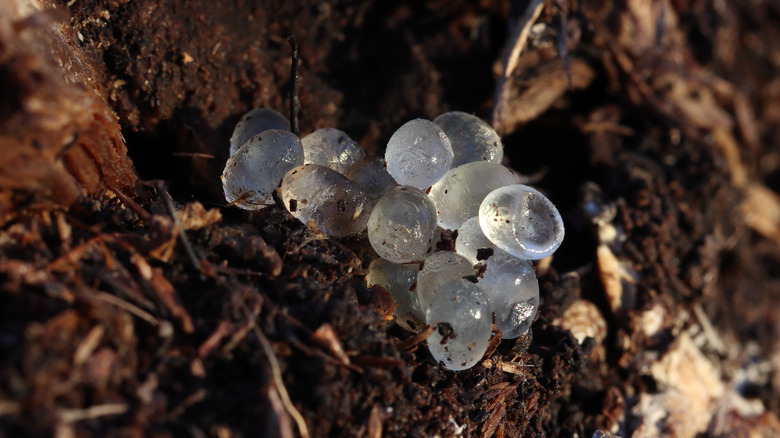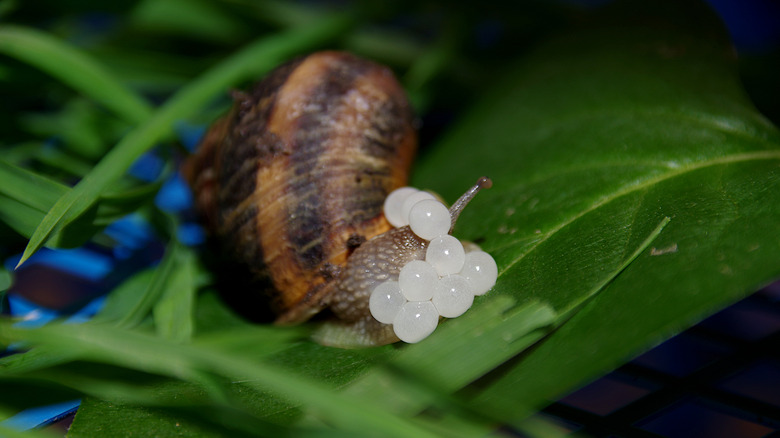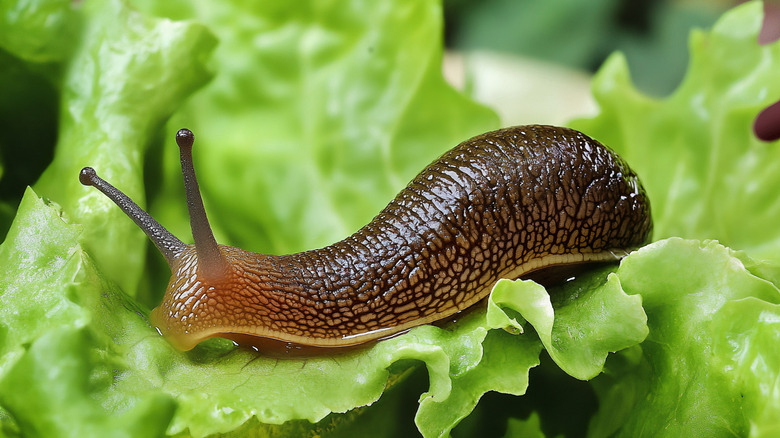What Clear Eggs Are A Warning Sign Of In The Garden, And What To Do Next
Your home garden should serve as a welcoming oasis that inspires you to take a break from the bustle of daily life. However, unwanted visitors may find your backyard garden equally inviting and be tempted to make themselves at home, putting your beloved plants at risk. A pest infestation can cause serious damage to your plants if you don't address the issue in a timely manner. This is why it's imperative to stay vigilant and inspect your garden frequently for signs of an infestation.
One common sign you might have a pest problem on your hands is the presence of clear eggs. These translucent eggs sometimes have a white or pink tint and can be found in small piles or clusters in garden soil, compost piles, underneath pots or planters, or attached to the underside of leaves. If you spot these eggs accumulating around your yard or garden, it could be a warning sign that you have a slug or snail problem on the horizon. These pests are infamous for feeding on leaves at night, damaging your plants and leaving them more vulnerable to diseases and other pests.
It's important to consider the environment that the gastropods prefer and frequently check ideal hiding spots to make sure the pests don't return and continue to multiply. Slugs and snails reproduce quickly, and populations can quickly grow out of hand, so consistent inspections can help catch the pest problem while it's small and still manageable. Here is how you can accurately determine if you have a snail or slug infestation, and the next steps you should take to eradicate them and prevent them from coming back.
How to identify a snail or slug infestation in your garden
It's important to accurately identify snail or slug eggs so that you can treat the problem accordingly. The first step to determining if you're dealing with these specific pests in your garden is by doing a thorough inspection of the area to see if you spot any white or pink translucent and gelatinous eggs or adult pests lurking in locations they find desirable. These gastropods prefer cool, moist areas that are out of direct sunlight and near a food source, so loose piles of soil near lush vegetation or sheltered dark areas are ideal hiding spots for them.
Another indicator that you have a slug or snail problem on your hands is if you spot a slimy trail of residue in your yard or garden. The pests are active at night, so sometimes it's easiest to spot these secretions first thing in the morning, after snails go into hiding during the daylight hours. Finally, if you notice bite marks or holes in your plants' leaves, it could be a sign that pests are feeding on them once the sun goes down.
If you do have a slug or snail problem in your yard, it's important to take immediate action to prevent the problem from snowballing and causing further damage. Inspect the area where the eggs or adult pests were found and determine if any nearby plants were affected. The process of removing both slugs and snails is relatively similar and straightforward. Here are the next steps you should take once you confirm your suspicions that you are dealing with a slug or snail problem at home.
Ways to eradicate the pest problem and prevent them from returning
Luckily, there are plenty of ways to eradicate a snail or slug problem and measures you can take to prevent them from returning. One of the simplest and most straightforward ways to prevent the eggs from hatching is to crush them or remove them by hand before they can hatch. For adult pests, handpicking them out of the garden or setting a homemade trap can also be effective methods that'll help you control snails and slugs in the garden. You can trap them easily by replicating a shelter that they would be attracted to, then disposing of them early in the morning when they flock to it to hide. You can also turn to common household ingredients, like vinegar, to control snail and slug populations in the garden by killing them.
There are also steps you can take to prevent the snails or slugs from coming back and making themselves right back at home. Keeping your yard clear of any unnecessary debris is wise since rocks, dead logs, and piles of soil make excellent homes for the pests to lay their eggs. Another simple solution is to use copper mesh to prevent snails and slugs from invading your home. You can create copper mesh barriers that surround your plants, which will deter the pests by giving them an electrical shock when their body makes contact with the copper. Regardless of the method you choose, it's important to remember there are plenty of options for both extermination and prevention, and as long as you remain diligent, there's no reason to panic.


